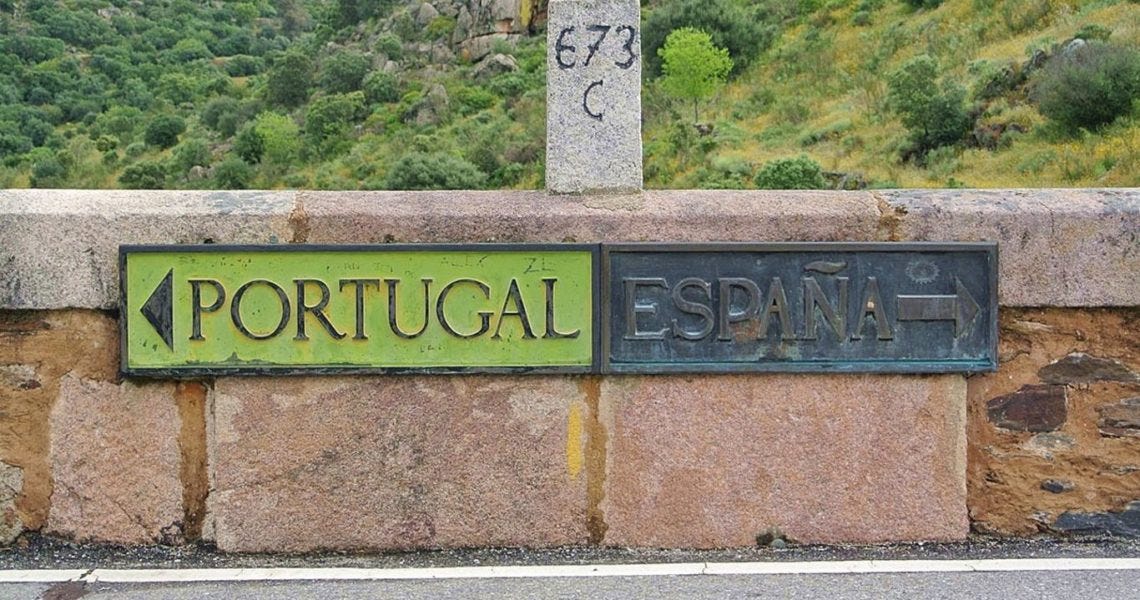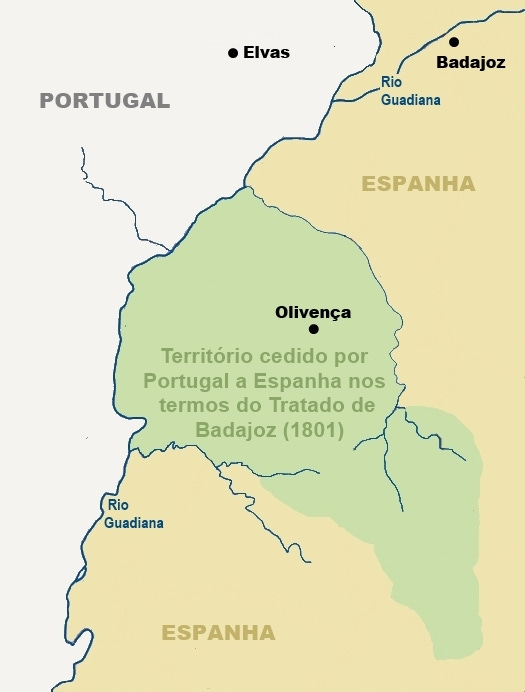The definition of a country can be viewed as a process rather than a fixed set of facts. Over time, rulers come and go, languages gain or lose importance, and borders are constantly molded, through conquer or capitulation. Borders tell the story of how the concept of a nation was crystalized, defining the rule of kings and the reach of a language.
The Stripe, also known as La Raya in Spanish or A Raia in Portuguese, is recognized as the longest uninterrupted border in the European Union. This border has separated Portugal from Spain since the late 1200s, making it one of the oldest borders in the world. Nevertheless, distinct periods of suzerainty, or overlordship, muddied the political separation between the two countries, as will be examined later.
Over the course of 700 years, numerous agreements defined and redefined the borders between Portugal and Spain. The geographic formation of Portugal began with the County of Portugal, which functioned as a vassal state within the Kingdom of Galicia, which itself existed as a dependency of the larger Kingdom of León [1].
In the early half of the 12th century, the County of Portugal fought two decisive battles which gained it independence - initially self-declared in 1139 and, later, officially recognized with the Treaty of Zamora in 1143. At this time, Portugal had its northern borders generally defined and, to the south, it reached as far as Lisbon. The new kingdom had attained roughly half of its current-day territory but there was still room for growth to the south. The period of constantly shifting borders continued for centuries [2].
The year 1249 saw the end of the Muslim occupation of the Kingdom of the Algarve, with the Portuguese capture of Faro. The Treaty of Badajoz in 1267 culminated in Spain agreeing to define Portugal’s southern border to the east, along the Guadiana river, and to the south with the Algarve region. It was only in 1297, with the Treaty of Alcañices, that Portugal’s modern border was generally established. That is, Spain had confirmed Portugal's sovereignty over the territories it already controlled.
Outliers
The Stripe includes outlier situations and small territorial disputes, such as the case of the town of Olivenza immediately south of Badajoz, to which both Spain and Portugal still claim ownership. The town, which was hard for the Portuguese to defend since it lies on the Spanish side of the Guadiana river, belonged to Portugal from 1297 but was taken by Spain in 1801 as a result of the supposedly unclear language of the (second) Badajoz Treaty. In 1815, another treaty was signed where Spain promised to return Olivenza but the actual transfer never came to pass, even more than two centuries later.
Just across the northern border of Portugal, another geographical outlier was the micro-state of Couto Misto, which was founded by monks and completely independent of both Spain and Portugal from the 9th to the 19th century. The country, roughly the size of the modern-day European micro-state San Marino, was nothing more than a monastery and a few hamlets in the mountains bordering both countries. It mostly existed in Spain although the small population spoke portunhol/portuñol, a mix of Spanish and Portuguese, as do many border towns up and down The Stripe.
Less than a three-hour drive from the former Couto Misto is Miranda do Douro, on the northwestern border of Portugal and Spain. While it is not a micro-state or an autonomous region, Miranda did develop its own culture and a language, known as Mirandese. Despite the minor language being spoken by less than 15,000 people, it enjoys co-official status in Portugal, alongside Portuguese.
As mentioned, border towns with their own language are not all that uncommon. Barranquenho, from the town of Barrancos in Portugal’s Alentejo region, is either considered an Alentejan Portuguese variety or an Extremaduran dialect depending on which academic one asks. The less than 2,000 residents of Barrancos would say that it is neither Portuguese nor Spanish, but wholly unique.
Directly between Miranda do Douro and Olivenza, while firmly in Spain’s Extremadura region, is an enclave of small towns where the Fala language is spoken by around 10,500 people. Similar to Barranquenho, it originates from the Middle Ages, and most speakers consider it to be its own autonomous language.
Outliers exist in other senses, not just geographically or linguistically. Over the millennia, the political unification of Iberia had as many successes as failures.
Iberism
Before Spain and Portugal were even countries, the Iberian Peninsula was unified several times. One of the early attempts was the Diocese of Hispania prior to the fall the Western Roman Empire, when the Iberian capital was Augusta Emerita where modern-day Mérida is located, near the Spanish-Portuguese border. It was founded by Augustus himself, and strategically positioned on a major Roman road, in an agriculturally fertile region, making it important for trade.
The next attempt at unifying the peninsula was a few centuries later, via the Caliphate of Cordoba. The Moorish invasion and occupation lasted from 711 to 1492, and brought the benefits of cultural exchange, scientific advancements, economic prosperity, and religious tolerance to the peninsula. Its peak, in territorial terms, was in the early 10th century when the Caliphate controlled two-thirds of Iberia from the southern capital of Cordoba.
By the Early Modern period, from 1580 to 1640, Spain and Portugal were jointly ruled by the Spanish House of Habsburg in a period known as the Iberian Union. During this time, while remaining otherwise independent, they shared the same three successive kings. That is, until tensions led to a 28-year war, which ended in 1668 with the Treaty of Lisbon. While Portugal considers the start of the war to be the date that it regained independence, Spain only recognized the fact with the signing of the treaty.
By the 18th and 19th centuries, an ideology called Iberism emerged which promoted the unification of both countries. Support generally came from Spanish intellectuals, authors and liberal politicians, meaning it was far from being mainstream. One Spaniard in particular, Sinibaldo de Mas, was such a proponent of unification that he wrote a book about the subject [5] which gained popularity in the political circles of Madrid and Lisbon. Its purpose was to highlight "the political, economic and social advantages of the union of the two peninsular monarchies into a single nation", with the suggestion that the Iberian capital be located in Santarém, near Lisbon.
The concept of unification still lingers, over 150 years later. According to a series of small university studies in Spain between 2009 an 2011, the Portuguese respondents were more open than Spaniards to political unification, a single taxation system and the removal of any and all restrictions regarding work [6]. When it came to required languages in school curriculum, the same trend was revealed although with a sharp disinterest for Portuguese as a required language in Spanish schools.
Iberism as a movement or a possible idea doesn’t die with a small study. The Spanish non-profit Sociedad Iberista Cultural, created in 2018 and based in Madrid, is “developing a practical and operative movement with civil society as a starting point”. The organization has eight regional bases across the peninsula, and focuses more on closer integration than full-blown federation.
An approximation, of course, wouldn’t eliminate the multitude of different cultural and linguistic contexts between Spain and Portugal. Variations lead to distinct observations and interpretations, even in areas that seem disjointed from culture or politics. In science, there are several concepts - such as the observer effect and uncertainty principle - that demonstrate how observation and distance from an object can intersect. In fact, the simple act of measuring a border - any border - turns out to be an essentially impossible task.
Paradoxes
In the 1950s, a British mathematician realized that Portugal’s border with Spain was measured by the Portuguese as being much smaller than Spain’s measurement of the same border. This phenomenon is called the Coastline Paradox [8] and it inspired the field of fractal geometry, showing that the smaller the unit of measurement, the more accurate the length of a border is.
Two countries coming to an agreement about where a border lies is not only a paradox of accurate measurements but also a definitional problem for determining if an administrative unit is a state or a country, for example. The Sorites paradox can be applied to this question, which says that if a pile of sand loses one grain at a time, when is it no longer a pile? In other words, small and incremental change can lead to larger transformations, even in the opposite direction.
The County of Portugal, albeit small, defended itself from the Moors and the Kingdom of León. It would seem that some grains of sand are more equal than others, as they tip the scales in one direction or another. In this case, self-defense, self-declaration and diplomatic recognition of Portuguese autonomy were essential to joining the “pile” category. The Sorites paradox shares a common problem with the concept of entropy, in that there are no clear boundaries between different states or conditions.
Between ordered and disordered states, the natural conclusion of something is that it falls apart. British physicist Brian Cox states, “everything in the universe is becoming more disordered and chaotic over time”, yet that depends if said entropy is considered high - which tends towards dissolution - or low - which coincides with order and structure. On a large enough timeline, even the anti-fragility of a sovereign state and its borders is transient.
Future Cooperation
On the other hand, the Lindy Effect states that something that has lasted will continue to last. The border between Portugal and Spain, which has existed for centuries, stands as a symbol of cooperation and mutual respect. Current examples include the Iberian Summits where both heads of state meet on a yearly basis to discuss common issues, the high-speed rail initiative between Lisbon and Galicia [9], and environmental cooperation by way of the Albufeira Convention [10, 11].
Should the border, or the entire European Union itself, be affected in the future by highly entropic political strife, hopefully the figurative bridges between the two countries become even shorter (something that is not possible when speaking of the literal kind). The most likely outcome, in the case of a dissolution of borders, is perhaps a reemergence of Iberism. Whether it is a softer or stricter version of previous iterations, time will tell.
Additional Information
1 - Portugal y España, una frontera de papel
2 - Iberian Union - What if Portugal and Spain United? (video, 13 min)
3 - What if the Reconquista failed? (video, 12 min)
4 - Coastline Paradox (videos: EN, 6 min / PT, 7 min)
5 - Las fortificaciones abaluartadas de la raya con Portugal
6 - Emperor of All Spain (Wikipedia)
Sources
1 - Timeline
2 - How the borders of Iberia changed in the Middle Ages
3 - Oliventine Portuguese (Wikipedia)
4 - Flag of Iberia
5 - La Iberia, por Sans i Mas
6 - Portuguese-Hispanic Opinion Barometer
7 - Sand castle picture
8 - Coastline Paradox (Wikipedia)
9 - Portugal is getting loads of swish new high-speed rail routes
10 - Acuerdo hispano-luso para combatir inundaciones y sequías
11 - Spanish-Portuguese Albufeira Convention






